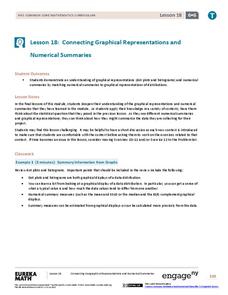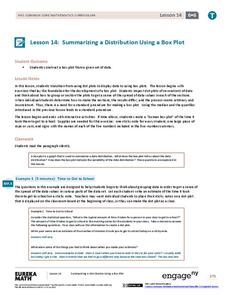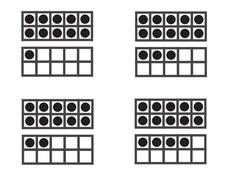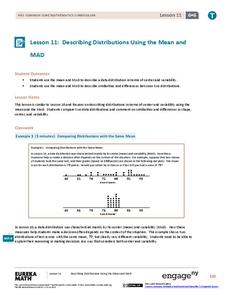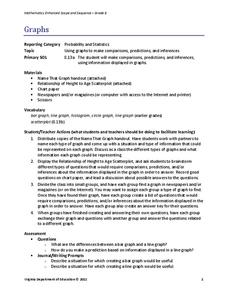EngageNY
Displaying a Data Distribution
Pupils analyze a display of data and review dot plots to make general observations about the highest, lowest, common, and the center of the data. To finish, learners match dot plots to scenarios.
Science Geek
Covalent Bonding
When it comes to covalent bonds, sharing is caring. Presentation covers the octet rule with multiple examples, Lewis Dot Structures with an example, and resonance. Presentation is the first in a five-part series.
Curated OER
What Shapes Can You See?
This clown is missing some things, and young counters sequence single-digit numbers to complete this juggling act. They connect four separate connect-the-dots sequences to create two triangles and two squares, then complete three more...
EngageNY
Connecting Graphical Representations and Numerical Summaries
Which graph belongs to which summary statistics? Class members build upon their knowledge of data displays and numerical summaries to connect the two. Pupils make connections between different graphical displays of the same data in...
EngageNY
Describing Distributions Using the Mean and MAD
What city has the most consistent temperatures? Pupils use the mean and mean absolute deviation to describe various data sets including the average temperature in several cities. The 10th lesson in the 22-part series asks learners to...
EngageNY
Understanding Box Plots
Scholars apply the concepts of box plots and dot plots to summarize and describe data distributions. They use the data displays to compare sets of data and determine numerical summaries.
Santa Monica College
Lewis Structures and Molecular Shapes
Learners practice drawing Lewis dot structures, build molecules with model kits, and predict molecular shapes using VSEPR theory. The combination of written work and hands-on reinforcement benefits young scientists.
EngageNY
Summarizing a Distribution Using a Box Plot
Place the data in a box. Pupils experiment with placing dividers within a data set and discover a need for a systematic method to group the data. The 14th activity in a series of 22 outlines the procedure for making a box plot based...
American Statistical Association
Bubble Trouble!
Which fluids make the best bubbles? Pupils experiment with multiple fluids to determine which allows for the largest bubbles before popping. They gather data, analyze it in multiple ways, and answer analysis questions proving they...
K-5 Math Teaching Resources
Small Ten Frame Cards with Dots
Solidify your mathematicians' addition and subtraction skills using this ten frame printable. Here, you'll find small, ten frame cards with dots representing numbers 11 to 22, equipped to enhance math strategies and boost proficiency.
Willow Tree
Line Plots
You can't see patterns in a jumble of numbers ... so organize them! Learners take a set of data and use a line plot to organize the numbers. From the line plot, they find minimum, maximum, mean, and make other conclusions about the...
Oregon Department of Education
Building Number Sense
It's never too early to begin a child's math education. This collection of fun hands-on activities engage youngsters in building their number sense as they learn how to count objects, identify numerals, compare amounts, and much more.
BBC
Walking with Dinosaurs
Breath new life into your class's study of dinosaurs with this extensive collection of materials. Offering everything from a printable T-rex mask, word searches, and connect-the-dots activities to informational handouts, hands-on...
EngageNY
Describing Distributions Using the Mean and MAD II
The 11th lesson plan in the series of 22 is similar to the preceding lesson plan, but requires scholars to compare distributions using the mean and mean absolute deviation. Pupils use the information to make a determination on which data...
Virginia Department of Education
Graphs
Examine different types of graphs as a means for analyzing data. Math scholars identify the type of graph from a series of data displays and then develop questions to match each one. Then, given a scatter plot of height versus age...
CK-12 Foundation
Two-Sided Stem-and-Lead Plots: Gamers
Which gender spends more time playing video games? Your classes use provided data to answer this question. They first build a two-sided stem-and-leaf plot and then use the display to look for patterns. Guiding questions help them...
Curated OER
Orange Dot to Dot
For this connect the dots worksheet, students connect the dots and draw a line using the numbers 1-10 to outline the picture of a orange.
Curated OER
Lemon Dot to Dot
In this connect the dots worksheet, students connect the dots and draw a line using the numbers 1-16 to outline the picture of a lemon.
Curated OER
Koala Dot to Dot
In this connect the dots worksheet, learners determine the animal holding the candy cane by joining the dots. Students start at 1 and count to 60 to connect the dots.
Curated OER
Christmas Bell Dot to Dot
In this Christmas dot to dot worksheet, students join the dots to draw the Christmas bell. Students start at 347 and count backwards by 1.
Curated OER
Dot to Dot Face
In this dot to dot worksheet, students count from 0 to 25 while connecting the dots. A man's funny face will be revealed. Students color the picture.
Curated OER
Dragonfly Dot To Dot
In this science worksheet, 2nd graders will connect the dots from one to forty-two to create a dragonfly. Students will respond to the question and write what the picture comes to be once it has been completed.
Curated OER
Connect the Dots: Polar Bear
In this connect the dots worksheet, students connect the dots to an animal that spends most of its life on shifting sea ice and is a marine mammal.
Curated OER
Connect the Dots
In this connect the dots worksheet, students connect the dots to link the numbers to reveal an amphibian that is known for its call.
Other popular searches
- Dot to Dot Worksheets
- Dot to Dot Puzzle
- Alphabet Dot to Dot
- Dot to Dot Picture
- Halloween Dot to Dot Picture
- Dinosaur Dot to Dot
- Duck Dot to Dot
- Dot to Dot 1 30
- Cat Dot to Dot
- Number Dot to Dot
- Dot to Dot Fish
- Dot to Dot Heroes



